2019 Audi Q3 SUV first test drive
The 2019 Audi Q3 has been re-engineered following a truly successful run for the first generation model. Originally launched in 2012 the Audi Q3 has sold over 1.1-million units so far. The follow-up model carries the usual “All-New” designation, but what else describes a vehicle that has been engineered anew from the ground up. It is 18-mm wider, 97-mm longer, has a more powerful engine option and it sits atop the corporate MQB platform, which it shares with the likes of the Audi A3, Audi TT, Volkswagen Golf and VW Tiguan. 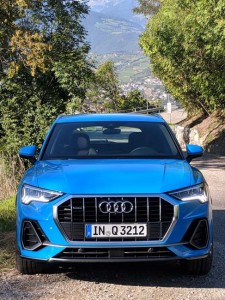
Audi has restyled the next-gen Q3 extensively. A bold new front facia includes a wide framed octagonal grille with vertical ribs. It is flanked by slim LED headlights. The visual effect matches the appearance of the recently introduced, and new range-topper, Q8. The chiselled high shoulders compliment wheel fender “blisters,” or bulges, that reference the Quattro rally car heritage. The aggressive new styling gives the Q3 a sharper look and a more rugged stance.
Inside, Audi has transferred a good portion of the cabin technology from the flagship A8 sedan. The Audi Virtual Cockpit instrument cluster is now standard equipment. The base system uses a 10.25-inch screen; the up-level version has a 12.3-inch screen. It integrates the key information with different views including a full-screen navigation map, and places it neatly ahead of the driver. 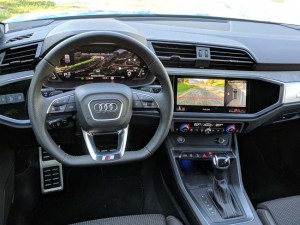
Another import from the A8 sedan is the black glass panel that hides a second 10.1-inch screen for Multi Media Interface (MMI) system. The black glass panel that runs from the instrument cluster across the centre of the dash, which gives the illusion of a single piece that extends from the drivers console to the curved dash surface. For ease of use it canted towards the driver. When illuminated, the second screen provides touchscreen access to the MMI and optional 15-speaker Bang & Olufsen audio system. The new touchscreen has done away with the rotary input knob used on earlier models. Thankfully, the new system is intuitive, although the old system was one of the easiest to use and so there was a slight sense of loss fuelled by nostalgia. The curved dash also allows for a better ergonomic experience when using the touchscreen.
Elsewhere, the driver and passenger seats provide the level of support and comfort expected of a luxury crossover and the sporty side bolsters are also large enough to accommodate by growing North American frame. The larger exterior dimensions result in more interior room. The cabin feels spacious and has a rear seat that can be adjusted fore and aft, which allows the driver to pick leg space or more storage room. The capacity is now rated at 530L with the rear seats set in the rearward position and 675 litres with it moved forward. Folding the rear seats down unlocks 1,525 litres of space. 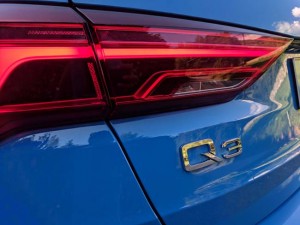
Audi has added rear cross traffic alert to the growing list of safety systems available on its vehicles. Audi Pre-Sense accident mitigation system remains standard along with side and active lane assist. Optional systems include Adaptive cruise control, park assist, cross traffic assist and the bird’s-eye view camera system.
Under the hood, Canadians will have a choice of the two most powerful gasoline engines offered on the Q3. The standard engine will be the 2.0L turbocharged four-cylinder with 187 horsepower and 236 pound-feet of torque. The top-level 2.0L engine produces 227 hp and 258 lb.-ft. of torque. In Canada, all Q3 models will work with a new seven-speed twin-clutch S-Tronic transmission and Audi’s famed Quattro all-wheel-drive system. 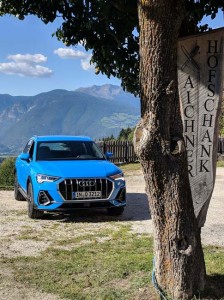
The Global press launch for the Audi Q3 was held in Bolzano, Italy, an area nestled in the Italian Alps. At first the location was a bit confusing for an urban-focused compact SUV. When the Audi reps handed over the keys the confusion quickly disappeared. The test vehicles were powered by the 227 hp engine and the twin-clutch transmission (the Euros get the choice of a manual gearbox ). One optional feature in the tested Q3 was the electronic adaptive damper system — the shocks tailor the response by offering highway comfort and a responsive firmness, which controls unwanted body roll.
Moving off from the parking lot at the airport in Bolzano, headed for the Tyrolean Alps, my first stab at the throttle revealed just how much the increased power has added to the character of the new Q3. The 0-100-km/h time comes in at 7.4 seconds and it has a top speed of 220 km/h. On the twisty Alpine roads, the new Audi Q3 felt quicker, sharper and, well, sportier than the outgoing model. The adaptive suspension soaked up the road ruffles and kept the vehicle flat through corners, giving the new Q3 the feel of sports car rather than a compact crossover. This shouldn’t be a surprise given that the Q3 shares its platform with the VW Golf GTI! Another noticeable improvement was the steering feel and response. The new variable speed and ratio rack has adds a whole new dimension to the feedback and the manner in which the Q3 turns into a corner. 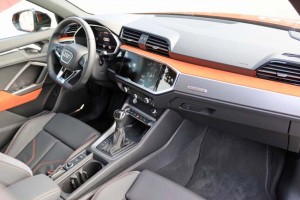
Of the test vehicles available at the press introduction, there were two colour-focused packages. These will become the launch models when the Q3 lands. The flashier of the two is a bright Pulse Orange paint scheme with piano-black trim replacing the usual chrome. Inside, there’s matching orange stitching on the black leather seating as well as a strip of orange Alcantara spanning the width of the dashboard. The second Chronos Gray model represents a slightly more sedate take on things.
While pricing has not been announced, the all-new 2019 Audi Q3 hit Canadian roads in the second-quarter of 2019. The pricing and final specifications will be confirmed closer to launch. 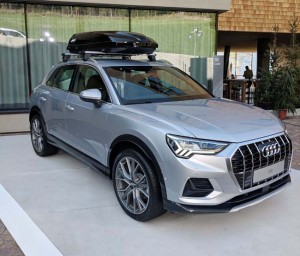
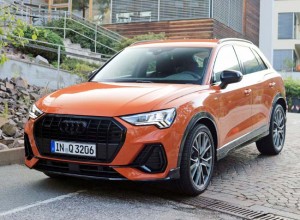
Copyright © Auto Reviews Online 2016 | Privacy & Terms of Use | info@autoreviewsonline.com | Website by Brolly Media
